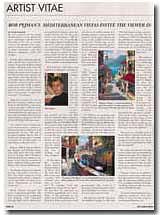Art World News - May 2004 Bob Pejman's Mediterranean Vistas by: Sarah Seamark |
|
No one is present in the classic Mediterranean scenes of Bob Pejman's paintings--only the viewer. The table set for two at a restaurant on the Amalfi Coast represents an invitation to the onlooker to place themselves and their desired companion within the setting. It is the effect of beauty and solitude together that creates this romantic mood that Pejman wishes to offer collectors of his work. He travels to Italy when he can to bring back in his mind images of its classic architecture and the passage of time worn layer by layer on its ancient stones. His palette reflects the terracotta green of the canals, azure blue of the coastline, earth tones of the country. "I don't paint for myself. I make paintings that I want people to appreciate and enjoy," says Pejman. Inspiration for his style, that he likens to romantic realism, comes from the Hudson River School, the classic landscapes of Thomas Cole and Frederick Church, the utopias of Maxfield Parish, and above all, from the Victorian artist Laurens Alma-Tadema, known for his theatrical paintings of Roman ruins. "I've always loved traditional art, and have a fascination with architecture and perspective," he says. "My work is not photo-realistic, but is a mix of realism and imagination. I considered myself to be a traditionalist--so I get drawn to the past a lot." Pejman spent his early childhood in Europe, where his father studied as a classical composer at the Vienna Academy of Music, while his mother played the harp in the Vienna Philharmonic. |
The family, which soon added a brother and sister, moved to Tehran when commissioned by the Shah of Iran to compose operas and ballets as head of the music department. Music flowed through the home, it was all around him. But Bob's real interest lay in painting and drawing. This continued through high school, which Bob attended in New Jersey after the family immigrated to the United States in '76. "My favorite class was art," he recalls. He also taught himself to play the piano at 15, and wrote music for the Jazz and marching bands at Summit High School, NJ. His father, however opposed a career in either art or music for his son, saying it would be hard to make a living. In a corporate job, he rationalized there would be a steady paycheck.
Bob listened to his father, and signed up at Rutgers University to study computer science. His arts instructor on the other hand did not think he was listening to his heart, rather following security. To this end, Bob earned a double major; computer science and music. At college he helped form the New Wave band X-Dream. They played clubs and bars and even made a record. His greatest hobby is still playing the piano and collecting soundtrack music. |
But Bob went on into the corporate world where he saw success, becoming vice president of marketing for a software company. At this time his mother, Homa opened Pejman Gallery in Short Hills, NJ and asked Bob to become a partner. "She needed someone to help her," he explains. "And this sparked my interest in art again." He was then 28, and had not touched a paintbrush in 11 years. Many of the paintings in the gallery were by European artists. "I looked at them, and I felt I could have been one of these artists. So I bought a paint set and canvas and started to paint again." But he was rusty--so he sought out the help of Anatoly Ivanov, one of the artists represented in the gallery who lived nearby and could teach Pejman to paint in a classical style. this was all done in his spare time from his full-time corporate job. Then, in 1993, Pejman Gallery gave him a one-man show. He sold seven acrylic on canvas paintings priced between $10,000 and $15,000. "This was much better than I thought I would do. So I decided to take it up seriously." In addition to studying with Ivanov, Bob also studied with the well-known Armenian Impressionist and colorist Ovanes Berberian. While Ivanov influenced the development of his classical style of painting, Berberian influenced his color palette to be that of impressionistic. The result is a blending of impressionistic colors and techniques to achieve a classical yet contemporary style. Bob also attended the New York Art Student's League in 1993 and |
1994, focusing his studies on drawing and human anatomy. The following year, 1995, he founded his art publishing company, Pejman Editions International. Four years later, he left the corporate world to pursue his art and publishing career on a full time basis. His studio is combined with his publishing business in a 3,000 square foot space in Whippany, NJ. Here he divides time between painting, now oils on canvas; hand-embellishing the deluxe editions and overseeing the publishing operation. "I am involved from concept to completion--from color correcting in Photoshop, to stretching, to embellishing," says Bob. "Every step of the way is done under my supervision so that I know exactly what goes out to the galleries." His prints are available in three forms. Deluxe editions of 395 each in two sizes, with only one or two images released each year. These are all hand embellished by Bob Pejman himself. Recently introduced is the Signature edition line of embellished prints, in two sizes. The edition for each size is 595 with 45 APs, the latter embellished by Bob. The Classic Collection is a line of miniature open editions prints measuring 9 by 12 inches. Pejman's work can be found incorporate and private collections throughout the world, and is available through select galleries in the U.S. including New York, Los Angeles, Atlanta, Las Vegas and Maui. Pejman's oils on canvas sell for $5,000-$50,000. To reach Pejman Editions International, log onto the website: www.PejmanEditions.com |

